Dos and Don'ts of Living Rooms For Rugs
When it comes to decorating, basic living room rules regarding layout and design can help you create a space that feels balanced, functional, and complete. Keep an eye on proper furniture sizes and spacing, the right amount of decor and accessories, the rug's appropriate shape and size, and the correct placement of lighting, all of which change the look and feel of the room.
Carpets vs Rugs
If you don't have wall-to-wall carpeting, choose a living room area rug or two to help define seating zones and anchor or unify the space. There are plenty of colour and pattern choices, but the size and placement of the rug will affect the way you feel in the room. Here are a few things to consider.
Rug Size
The rug size for your living room should not be too small. Ideally, all four legs of all furnishings should fit on the rug. At least the front legs of every piece of furniture should fit on the rug. But all the legs of your smaller pieces should fit on the rug. There are exceptions, though—if you have a small living room, putting just the four legs of a coffee table on the rug looks balanced and well-placed. A sectional sofa, however, should always have all of its legs on the rug to unify its size and shape.

Placement
Use an area rug to cover the entire living room floor, almost like wall-to-wall carpeting. Or you can place the rug in the center of the room if your furniture is pulled away from the walls. For added interest, layer area rugs one on top of another or layer an area rug on top of wall-to-wall carpeting.
Carpets vs Rugs Pros and Cons: Making the Right Choice for Your Space
When deciding between carpets and rugs, consider the unique advantages and drawbacks of each. Carpets offer wall-to-wall coverage and superior insulation, ideal for larger spaces and colder climates. They provide a consistent look throughout the room but can be challenging to clean and replace. Rugs, on the other hand, offer flexibility in design and placement, allowing for easy updates to your decor. They're typically easier to clean and replace but may not provide the same level of insulation. Consider factors such as room size, maintenance preferences, and desired aesthetic when making your choice.
Rug vs Carpet vs Mat: Understanding Floor Covering Options
Distinguishing between rugs, carpets, and mats helps in selecting the right floor covering for your needs. Carpets are wall-to-wall installations, providing full coverage and a permanent solution. Rugs are movable floor coverings, available in various sizes and designs, offering flexibility in placement and style. Mats are typically smaller, functional pieces designed for specific purposes like entrance ways or anti-fatigue support in kitchens. Each option serves different needs in terms of coverage, durability, and functionality, so consider your space requirements and intended use when choosing.
Rug vs Mat: Choosing the Right Floor Accessory
While both rugs and mats enhance floor spaces, they serve different purposes. Rugs are generally larger and more decorative, used to define areas within a room or add style to your decor. They come in various sizes, materials, and designs, making them versatile for different spaces. Mats, conversely, are typically smaller and more functional, often used in entryways, kitchens, or bathrooms. They're designed for specific purposes like trapping dirt, providing cushioning, or preventing slips. Consider the intended use and location when deciding between a rug or mat for your space.
Carpets vs Rugs Cost: Budgeting for Floor Coverings
When comparing the costs of carpets and rugs, several factors come into play. Carpeting typically has a higher upfront cost due to the larger coverage area and professional installation required. However, it can be more cost-effective for covering large spaces. Rugs offer more flexibility in pricing, ranging from budget-friendly options to high-end designer pieces. They're generally less expensive for smaller areas but can add up if used to cover large spaces. Consider long-term factors like maintenance, cleaning, and replacement costs when budgeting for your floor covering choice.

Carpet or Rug for Living Room: Choosing the Perfect Floor Covering
Deciding between carpet and rug for your living room depends on various factors. Carpets provide class="font-semibold" node="[object Object]">wall-to-wall comfort and a cohesive look, ideal for larger living rooms or those seeking a cosy atmosphere. They're excellent for noise reduction and insulation. Rugs offer more design flexibility, allowing you to define seating areas, add colour accents, or change your decor easily. They're also easier to clean and replace. Consider your living room's size, your lifestyle (e.g., pets, children), and how often you like to update your decor when making your choice.
Difference Between Carpets and Rugs PPT: Key Distinctions Explained
Understanding the differences between carpets and rugs is crucial for making informed decor decisions:
- Installation: Carpets are fixed, wall-to-wall installations; rugs are movable.
- Size: Carpets cover entire floors; rugs come in various sizes.
- Flexibility: Rugs offer easy replacement and repositioning; carpets are more permanent.
- Maintenance: Rugs are generally easier to clean and maintain than carpets.
- Design Options: Rugs provide more variety in patterns and can be easily changed.
- Cost: Carpets typically have higher initial costs but can be more economical for large areas.
Consider these factors when choosing between carpets and rugs for your space.
Carpet or Rug in Bedroom: Creating a Cosy Sleeping Environment
Choosing between carpet and rug for your bedroom depends on personal preference and practical considerations. Carpets offer wall-to-wall softness and excellent noise reduction, creating a serene atmosphere ideal for sleep. They provide consistent warmth underfoot, especially appreciated on cold mornings. Rugs, however, offer more design flexibility and can be easily changed to update your bedroom's look. They're also easier to clean and replace, which can be beneficial for allergy sufferers. Consider factors like room size, maintenance preferences, and your desired bedroom ambiance when making your decision.

Carpet vs Rug Reddit: Community Insights and Preferences
Reddit discussions on carpets versus rugs reveal diverse opinions based on personal experiences. Many users appreciate rugs for their versatility and ease of cleaning, especially in rental properties or homes with pets. Carpets are often favoured for their full coverage and consistent comfort, particularly in bedrooms and living rooms. Redditors frequently mention the importance of considering factors like climate, lifestyle, and personal style when choosing between carpets and rugs. Some users recommend a combination, using area rugs over hard floors or even layered over carpets for added style and comfort.
How to Position a Rug in Living Room: Maximising Style and Functionality
Positioning a rug correctly in your living room can enhance both aesthetics and functionality. For a cohesive look, ensure the rug is large enough to accommodate all furniture legs in your seating area. In larger rooms, use the rug to define separate zones, such as conversation areas or reading nooks. For smaller spaces, consider placing the front legs of furniture on the rug to create a sense of unity. Always leave a border of flooring visible around the rug's edges for a balanced appearance. Consider traffic patterns to ensure the rug doesn't impede movement through the room.
Dos and Don'ts of Living Rooms for Rugs Cheap: Budget-Friendly Styling Tips
When selecting affordable rugs for your living room, keep these dos and don'ts in mind:
Do:
- Choose durable materials like polypropylene for high-traffic areas
- Opt for neutral colours that complement various decor styles
- Consider layering smaller rugs for a trendy, budget-friendly look
Don't:
- Skimp on size; an undersized rug can make the room feel disjointed
- Forget to use a rug pad, even with cheaper rugs, to prevent slipping
- Overlook online marketplaces and sales for finding quality rugs at lower prices
Remember, a well-chosen affordable rug can significantly enhance your living room's appearance without breaking the bank.

Rug Placement Living Room with TV: Enhancing Viewing Comfort
When placing a rug in a living room with a TV, consider both aesthetics and functionality. Position the rug to define the seating area, ensuring it's large enough to accommodate all furniture legs. For optimal viewing comfort, the rug should extend beyond the coffee table, providing a soft surface for feet while watching TV. In larger rooms, consider using the rug to create a distinct TV viewing zone, separate from other living room areas. Avoid placing the rug too close to the TV stand to prevent tripping hazards. Choose a rug with a low pile for easy movement of rolling furniture like media consoles.
How to Place a Rug in a Small Living Room: Maximising Space and Style
In a small living room, strategic rug placement can enhance the perception of space. Opt for a rug size that allows for a consistent border of visible flooring around all edges, typically 15-20 cm. Position the rug to define the main seating area, placing at least the front legs of furniture on the rug. Consider a lighter coloured rug to create an illusion of more space. For very small rooms, a round rug can soften the space and create a sense of flow. Avoid cluttering the rug with too many furniture pieces; instead, use it to anchor the main seating arrangement.
8x10 Rug Placement In Living Room: Optimal Arrangements for Standard Sizes
An 8x10 rug offers versatile options for living room placement. In a typical arrangement, position the rug so that all furniture legs rest on it, creating a cohesive seating area. For larger rooms, place only the front legs of sofas and chairs on the rug, allowing for a spacious feel. In open-plan spaces, use the 8x10 rug to define the living area distinctly from dining or work zones. Ensure the rug is centred in the room or seating arrangement for a balanced look. Leave at least 15-20 cm of floor visible around the rug's edges to frame the space effectively.
Rug Under Couch Rules: Guidelines for Stylish and Functional Placement
When placing a rug under a couch, follow these key rules for optimal results:
- Size Matters: The rug should extend at least 15-20 cm beyond the couch on all sides.
- Consistent Placement: All furniture legs should either be on or off the rug for a cohesive look.
- Front Legs Rule: At minimum, the front legs of all seating should be on the rug.
- Traffic Flow: Ensure the rug doesn't impede doorways or natural walking paths.
- Proportion: The rug should be proportional to the room and furniture arrangement.
Following these guidelines will help create a balanced, stylish living space that feels well-coordinated and intentional.
Rug Placement Living Room with Fireplace: Enhancing Focal Points
When placing a rug in a living room with a fireplace, consider the fireplace as a natural focal point. Position the rug to complement the fireplace, not compete with it. For a traditional look, centre the rug in front of the fireplace, ensuring it extends under the main seating area. In larger rooms, use the rug to define a conversation area facing the fireplace. Leave some bare floor space between the rug and the fireplace to create a safe, visually appealing transition. Choose a rug size that allows for a consistent border of visible flooring around the edges, typically 15-20 cm, to frame the space effectively.

How to Place Rug in Living Room with Sectional: Accommodating Unique Shapes
Placing a rug with a sectional sofa requires careful consideration of shape and size. Ideally, choose a rug large enough to accommodate all legs of the sectional. For a cohesive look, ensure the rug extends at least 15-20 cm beyond the edges of the sectional. In L-shaped rooms, consider using the rug to mirror the shape of the sectional, defining the seating area. For larger spaces, you might opt for a round rug to soften the angular lines of the sectional. Always ensure there's enough rug space in front of the sectional for a coffee table and comfortable foot placement.
People Also Asked
Which type of rug is best for a living room?
The best rug for a living room depends on your specific needs, but wool rugs are often ideal. They offer durability, comfort, and natural stain resistance. For high-traffic areas, consider synthetic fibers like polypropylene for easy maintenance and longevity.
How to design a living room with an area rug?
Design a living room with an area rug by using it as a focal point. Choose a size that anchors your furniture and a style that complements your decor. Use the rug to define seating areas and create a cohesive look by pulling colors from the rug into your room's accessories.
Should a rug go under the sofa?
Yes, a rug should ideally go under the sofa. For a cohesive look, ensure that the rug extends at least 6-8 inches beyond the sofa on all sides. This helps to anchor the furniture and create a unified seating area.
Where should I put my rug in my living room?
Place your rug in the center of your main seating area. Ideally, it should be large enough to fit under the front legs of all furniture pieces. This arrangement helps to define the space and create a cohesive look in your living room.
Is bigger rug better for living room?
Generally, a larger rug is better for a living room. It helps to unify the space, make the room appear larger, and provide a more luxurious feel. However, ensure there's still some visible floor space around the edges to avoid overwhelming the room.
Is it OK to not have a rug in living room?
It's perfectly acceptable to not have a rug in a living room. Bare floors can create a sleek, modern look and are easier to clean. However, rugs do offer benefits like noise reduction, comfort underfoot, and the ability to tie design elements together.
How to pick a rug color for a living room?
Choose a rug color that complements your existing decor. Consider the room's color scheme and select a rug that either harmonizes with it or provides an interesting contrast. For versatility, neutral tones work well, while bold colors can make a statement.
How to pick a rug pattern?
Select a rug pattern based on your room's existing decor. For rooms with patterned furniture or wallpaper, choose a solid or subtly patterned rug. In rooms with solid colors, a bold pattern can add visual interest. Consider the scale of the pattern in relation to your room size.
What type of rug is most comfortable?
The most comfortable rugs typically have a high pile or shag texture. Wool rugs are naturally soft and cozy, while plush synthetic fibers can also provide excellent comfort. For ultimate luxury, consider silk rugs or high-quality wool-silk blends.
What is a good thickness for a living room rug?
A good thickness for a living room rug is typically between 1/4 to 1/2 inch. This provides enough cushioning for comfort while still allowing furniture to sit stably. Thicker rugs (up to 3/4 inch) can add luxury but may require furniture coasters.
What kind of rug is popular?
Currently, vintage-inspired and bohemian-style rugs are very popular. Geometric patterns and neutral color palettes with pops of color are also trending. For a timeless look, Persian-style rugs remain a classic choice in many interiors.
How big should a rug be under a couch?
A rug under a couch should extend at least 6-8 inches beyond the sides and front of the sofa. For a larger room, aim for 12-18 inches. The rug should be large enough to accommodate all front legs of the furniture in your seating arrangement.
How do you put a rug in an awkward living room?
In an awkward living room, use a rug to create a focal point or define separate areas. Consider using multiple smaller rugs to break up the space or an irregularly shaped rug to complement unusual room layouts. Ensure the rug placement enhances the room's flow.
How do I make my living room look bigger with a rug?
Make your living room look bigger with a rug by choosing a large size that extends close to the walls. Light colors and simple patterns can also create an illusion of more space. Ensure the rug is proportional to the room and furniture arrangement.
Where to put a rug in the living room?
Place the rug in the center of your main seating area. It should anchor your furniture arrangement, with at least the front legs of all seating pieces on the rug. This placement helps to define the space and create a cohesive look.
What is a nice size area rug for living room?
A nice size for a living room area rug is typically 8x10 feet or 9x12 feet for average-sized rooms. These sizes usually allow for all furniture legs to be on the rug or at least the front legs, creating a cohesive and well-proportioned look.
How far should living room rug be from wall?
Ideally, leave 12-18 inches of bare floor between the rug and the walls in a living room. This creates a balanced look and prevents the room from feeling overcrowded. In smaller rooms, 8 inches can suffice while maintaining proportion.
Is rug a must for living room?
While not absolutely necessary, a rug can greatly enhance a living room. It adds warmth, comfort, and can tie design elements together. Rugs also help with noise reduction and can define spaces within open floor plans.
Can a rug be smaller than a couch?
While possible, a rug smaller than a couch often looks disproportionate. Ideally, the rug should extend beyond the width of the couch by at least 6-8 inches on each side. This creates a more balanced and visually appealing arrangement.
Can a rug be too big for a room?
Yes, a rug can be too big if it leaves less than 8-12 inches of bare floor around its perimeter. An oversized rug can make a room feel smaller and overwhelmed. The rug should complement the room's proportions, not dominate the space.
What color should rug be in living room?
The rug color should complement your existing decor. Neutral tones like beige, gray, or taupe offer versatility, while bold colors can make a statement. Consider your room's color scheme and choose a rug that either harmonizes or provides an interesting contrast.
Can you have different rugs in a living room?
Yes, you can use different rugs in a living room, especially in large or open-plan spaces. Ensure the rugs complement each other in style, color, or pattern to maintain a cohesive look. Use different rugs to define separate areas within the room.
How to tell if an area rug is good quality?
Assess rug quality by checking its material, knot density, and construction. High-quality rugs often use natural fibers like wool or silk, have a higher knot count, and feature hand-knotted or hand-tufted construction. Check for even patterns and colorfastness.
What type of area rug is in style?
Currently, vintage-inspired and bohemian-style rugs are very trendy. Geometric patterns, neutral color palettes with pops of color, and sustainable materials are also popular. For a timeless look, Persian-style rugs remain a classic choice.
Do you need a rug in small living room?
While not mandatory, a rug can benefit a small living room by adding warmth and defining the space. Choose a rug that's proportional to the room size. A well-placed rug can make a small room feel more cohesive and inviting.
What color rug for a small living room?
For small living rooms, light-colored rugs can make the space feel larger and brighter. Consider neutral tones like beige, light gray, or cream. If you prefer color, choose soft, muted shades rather than dark or bold hues to maintain an open feel.
Where should a rug be placed in a living room?
In a living room, a rug should be placed to anchor the main seating area. Ideally, position the rug so that all furniture legs can rest on it, or at least the front legs of larger pieces. This creates a cohesive and defined space within the room. Ensure the rug extends beyond the seating arrangement to avoid a cramped look. For open-plan spaces, use the rug to delineate the living area from other functional zones.
How to place a rug in a living room with TV?
When placing a rug in a living room with a TV, focus on creating a balanced viewing area. Position the rug in front of the TV, extending it to encompass the seating arrangement. Ensure the rug is large enough to accommodate all furniture pieces in the TV viewing zone. This not only defines the space but also adds comfort and reduces glare on the screen. Consider leaving some space between the TV stand and the rug's edge for a clean, organized look.
What is the rug rule for sofas?
The rug rule for sofas emphasizes proper sizing and placement. Ideally, all legs of the sofa should rest on the rug. If this isn't possible, ensure at least the front legs are on the rug. For a standard three-seater sofa, the rug should extend about 6-8 inches beyond each side. This rule helps to visually connect the sofa with other furniture pieces and creates a cohesive seating area. Remember, a rug that's too small can make the room feel disjointed.
Should I put a rug under my chair?
Placing a rug under a chair can enhance comfort and style. For dining chairs, ensure the rug extends at least 24 inches beyond the table's edge to accommodate pushed-out chairs. For accent chairs in living spaces, the chair can be partially or fully on the rug, depending on the room's layout. A rug under a chair adds warmth, defines the seating area, and protects the floor from scratches. In home offices, consider a chair mat instead to facilitate easy movement.
What is the best color rug for a living room?
The best color rug for a living room depends on your existing decor and personal style. Neutral tones like beige, gray, or cream offer versatility and can make a room appear larger. For a bolder look, consider deep blues, rich reds, or emerald greens to add depth and character. If your furniture is neutral, a colorful or patterned rug can serve as a focal point. Conversely, if you have vibrant furniture, a more subdued rug can balance the space. Always consider the room's lighting and overall color scheme when choosing your rug color.
How to position a rug in a living room?
Positioning a rug in a living room requires careful consideration of the room's layout and furniture arrangement. Center the rug in the main seating area, ensuring it's large enough to accommodate all or most of the furniture. Leave about 12-18 inches of floor space around the rug's edges for a balanced look. In open-plan spaces, use the rug to define separate functional areas. For rooms with a fireplace, align the rug parallel to the hearth to create a harmonious layout. Remember, the rug should complement, not compete with, the room's focal points.
Can you have 2 rugs in a living room?
Yes, you can have two rugs in a living room, and this approach can add depth and visual interest to your space. When using multiple rugs, ensure they complement each other in style, color, or pattern to maintain cohesion. Use different sized rugs to define separate areas within the room, such as a seating area and a reading nook. Avoid placing rugs too close together, as this can create a cluttered look. Layering rugs is another trendy option, with a larger, neutral rug as a base and a smaller, more decorative rug on top.
What is the rule on rugs in living room?
The primary rule for rugs in a living room is to create a cohesive and balanced space. The rug should be large enough to accommodate all or most of the furniture in the main seating area. Aim for at least 6-8 inches of rug extending beyond the edges of your furniture. In larger rooms, use rugs to define separate functional areas. Ensure the rug's style and color complement the room's decor. For visual balance, leave some floor space visible around the rug's edges. Remember, these rules are guidelines; ultimately, the rug should enhance your room's comfort and aesthetics.
Does a rug have to be centered with couch?
While centering a rug with a couch is a common approach, it's not an absolute rule. The key is to create a balanced and harmonious arrangement. In most cases, centering the rug with the couch helps achieve this balance. However, in asymmetrical layouts or rooms with unique architectural features, off-center placement can be more visually appealing. The most important factor is ensuring the rug properly defines the seating area and accommodates all or most of the furniture pieces. Always consider the overall room layout and traffic flow when positioning your rug.
How do you throw a rug on a couch?
Throwing a rug on a couch, or draping it over the back, can add texture and visual interest to your living space. Choose a lightweight, decorative rug or a colorful throw blanket for this purpose. Fold the rug in half or thirds lengthwise, then drape it over the back of the couch, allowing it to hang evenly on both sides. For an asymmetrical look, position it off-center or at an angle. Ensure the rug doesn't interfere with seating comfort. This technique works well for adding a pop of color or pattern to a neutral couch, or for seasonally updating your decor.
Is it better to have a rug too big or too small?
When choosing between a rug that's slightly too big or too small, it's generally better to opt for the larger size. A rug that's too small can make a room feel disjointed and can actually make the space appear smaller. A slightly oversized rug, on the other hand, can create a sense of luxury and spaciousness. It's easier to work with excess rug by tucking it under furniture than to compensate for a rug that doesn't adequately cover the desired area. However, avoid rugs so large that they overwhelm the room or extend into inappropriate areas like doorways.
What is the rule of thumb for rugs?
The rule of thumb for rugs focuses on proper sizing and placement to enhance a room's aesthetics and functionality. In living rooms, aim for a rug large enough to accommodate all furniture legs, or at least the front legs of major pieces. For dining areas, ensure the rug extends at least 24 inches beyond the table on all sides. In bedrooms, place large rugs under the bed with ample exposure on the sides, or use smaller rugs beside the bed. Generally, leave 12-18 inches of floor visible around the rug's edges. These guidelines help create a balanced, cohesive look while defining functional spaces within a room.
Related Blog Posts
How to Design Your Living Room?
7 Living Room Design Ideas to Transform Your Home
Styling Tips for Large Grey Rugs in Living Room Décor
Related Rug Collections
Area Rugs




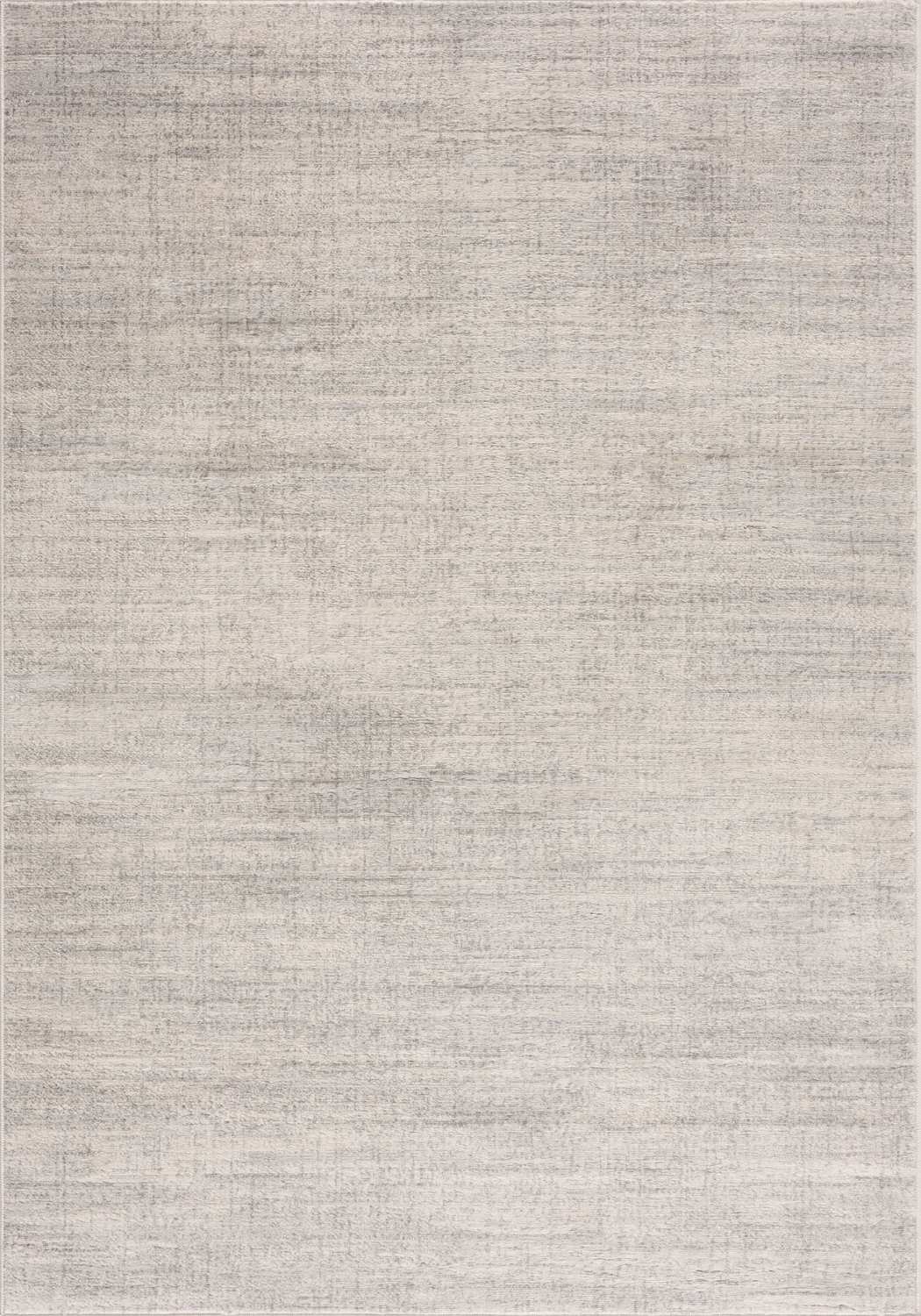
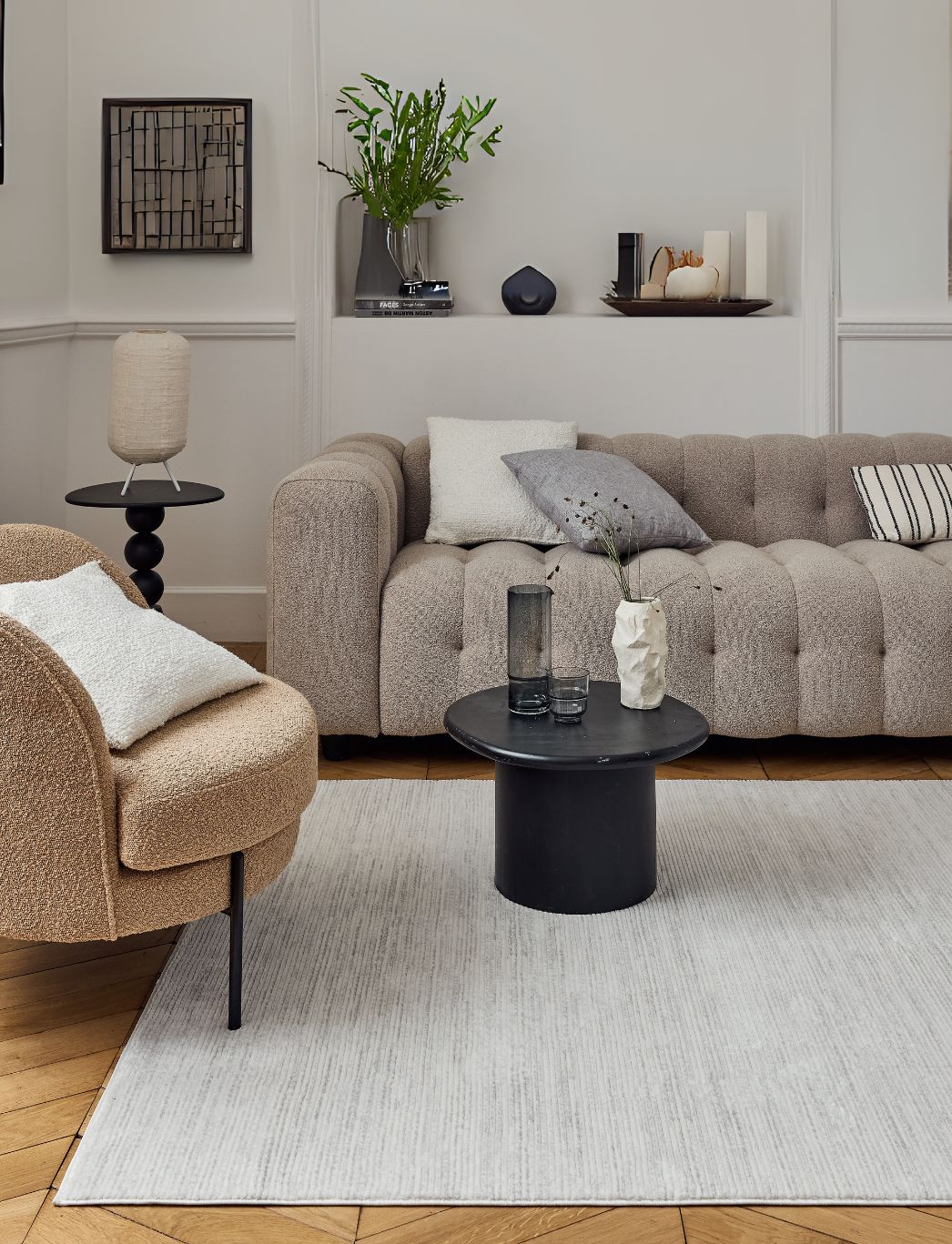
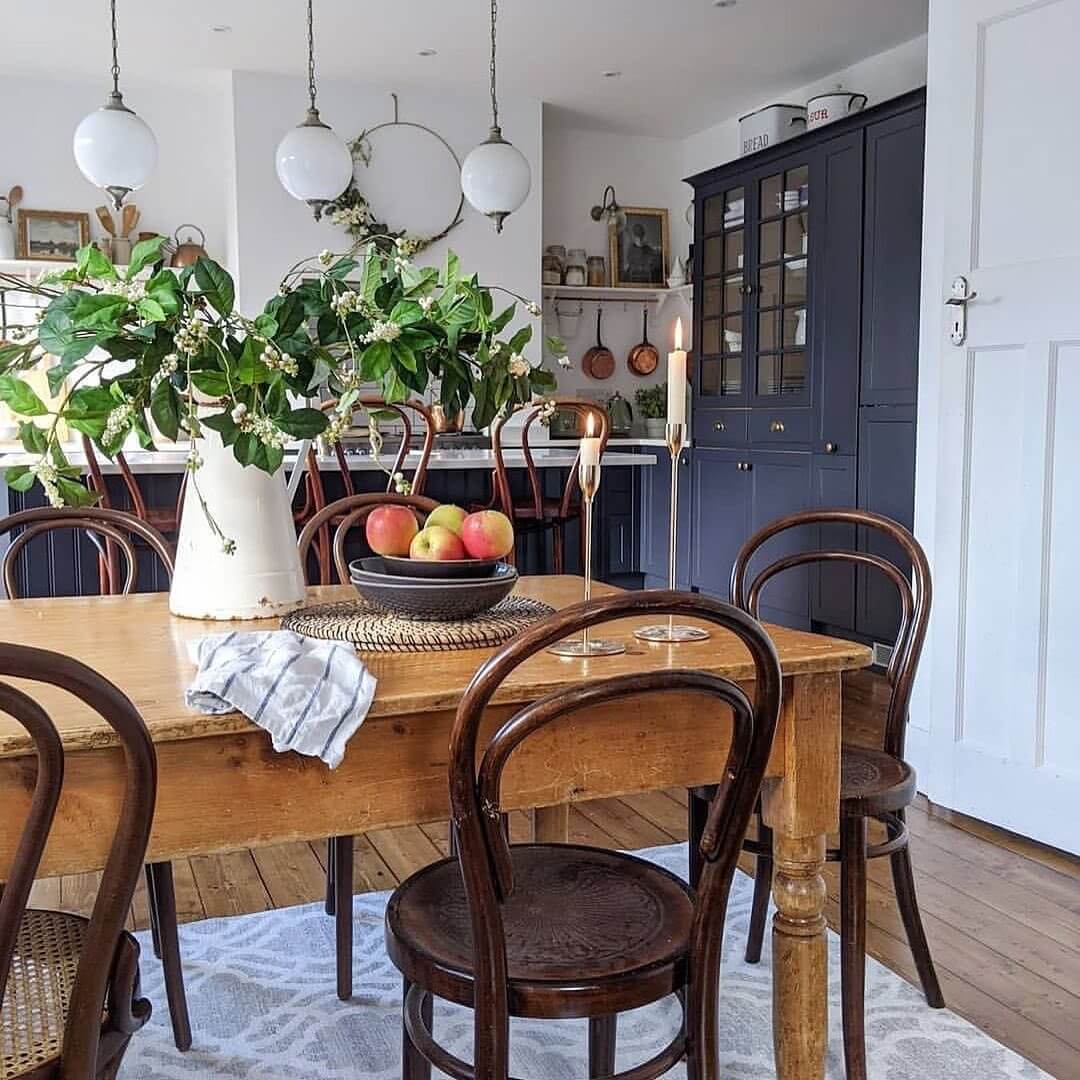
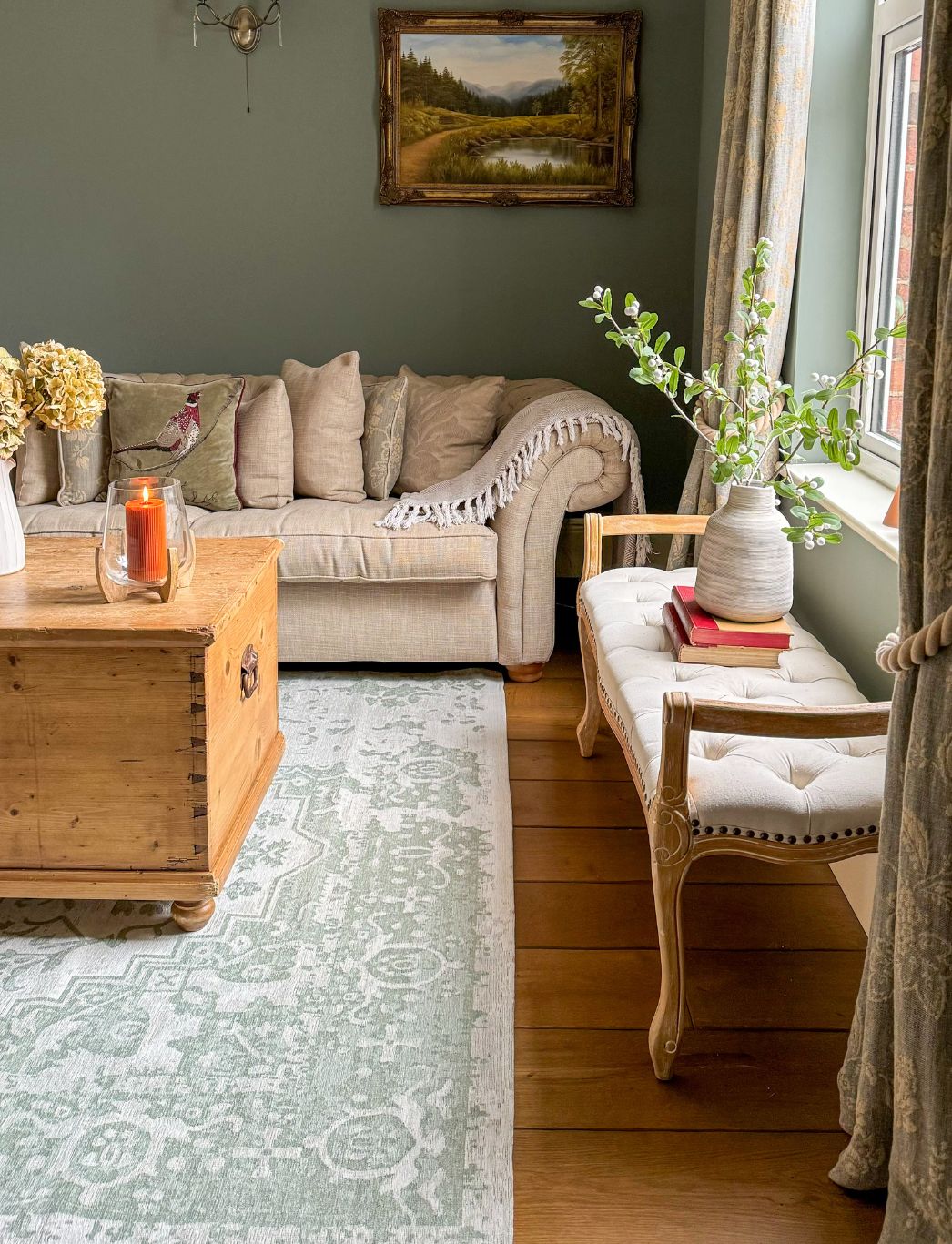
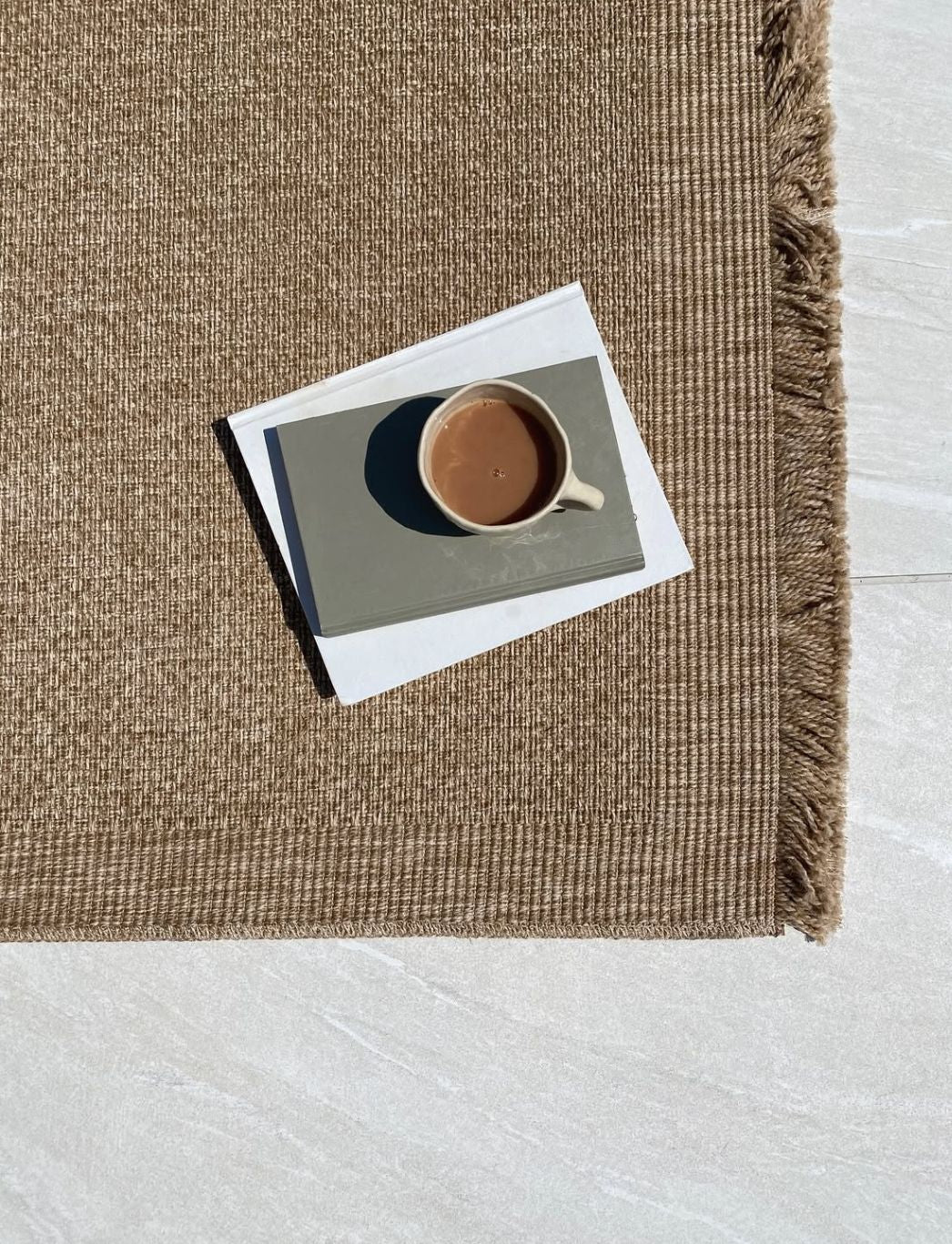
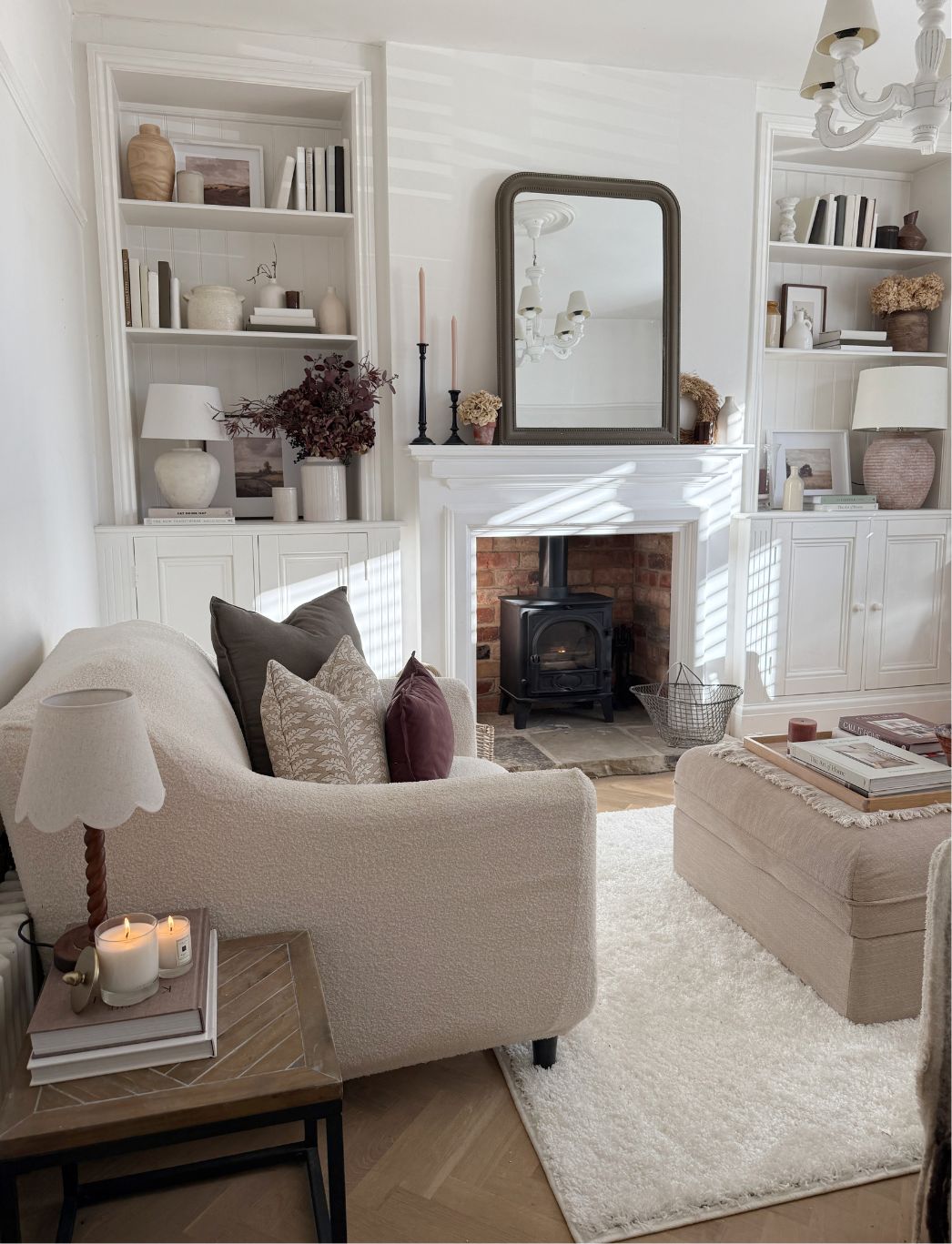
Leave a comment